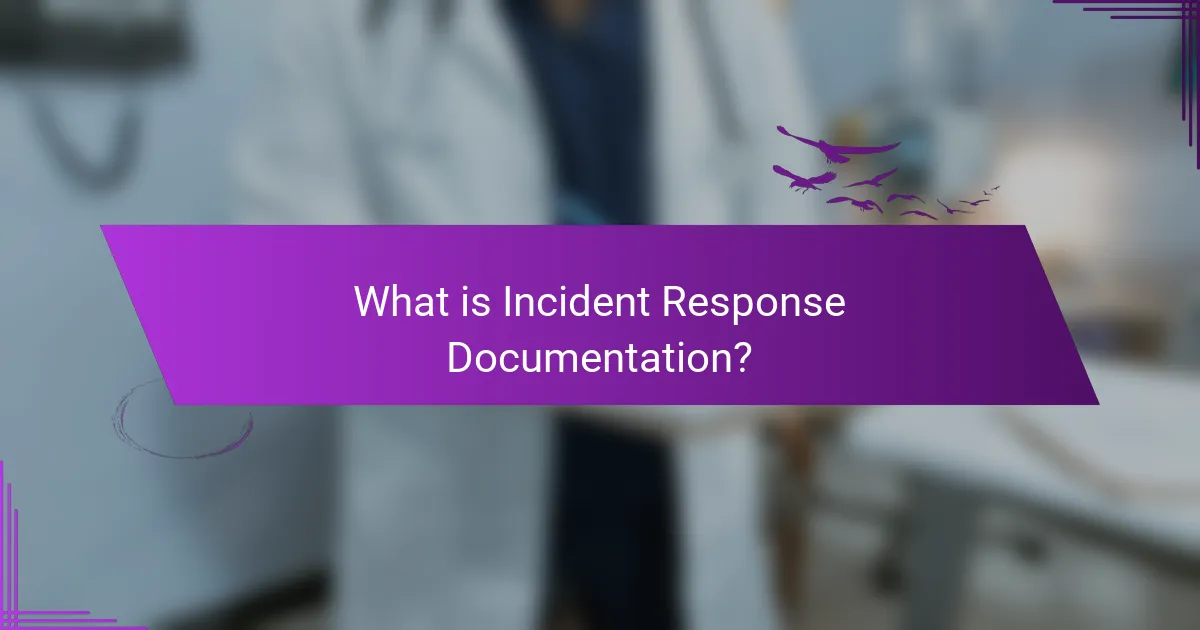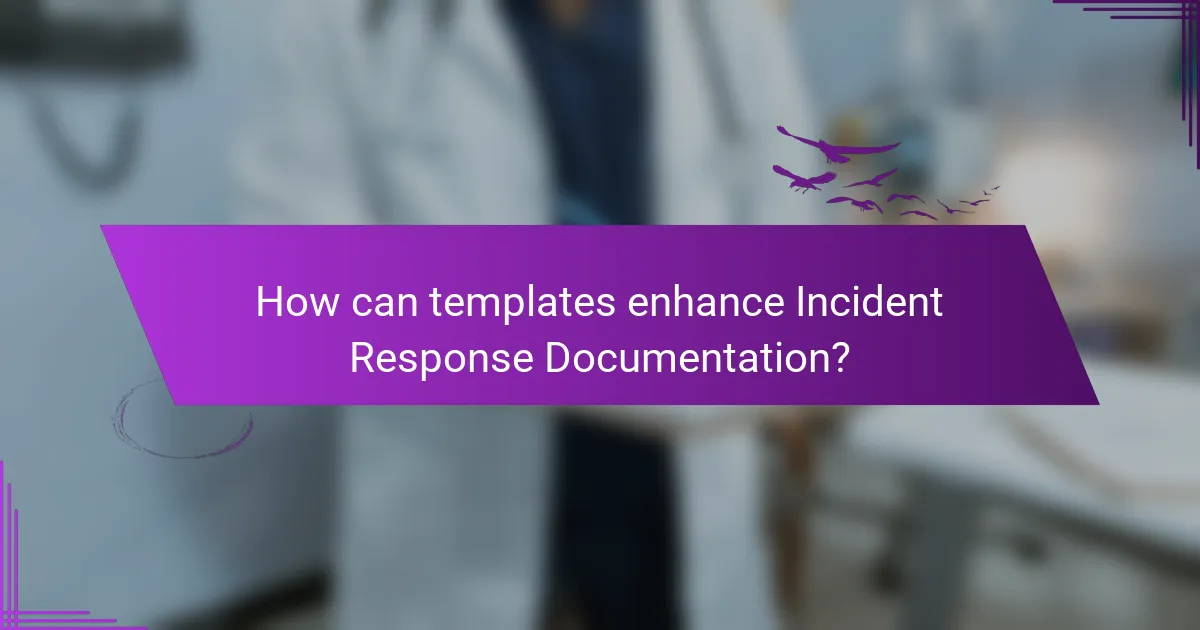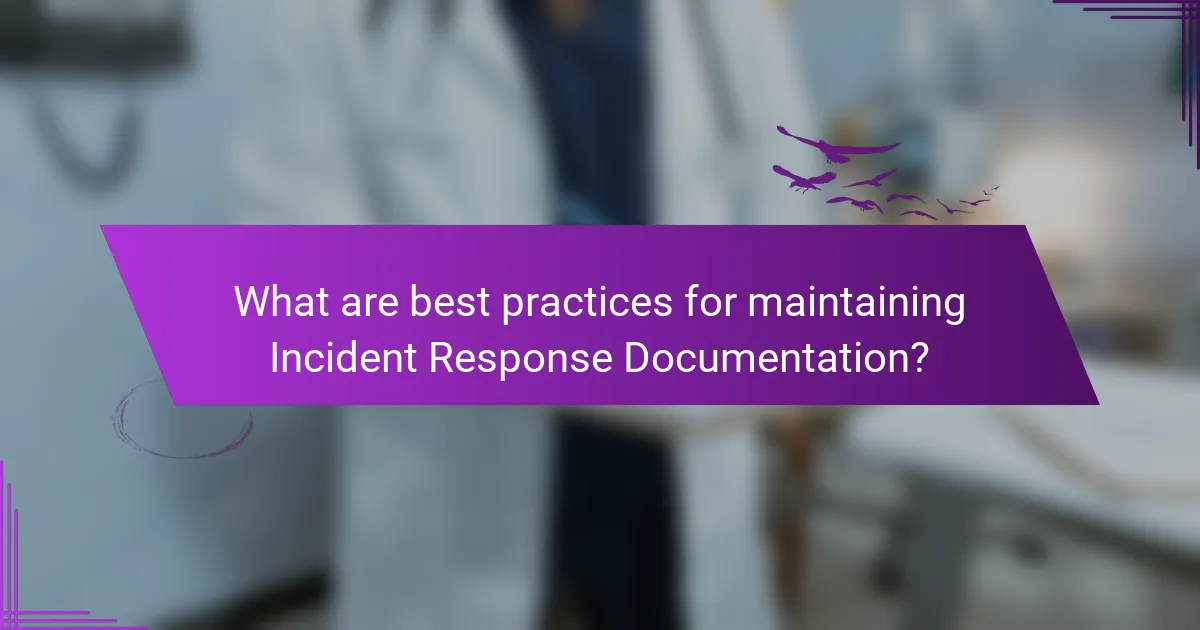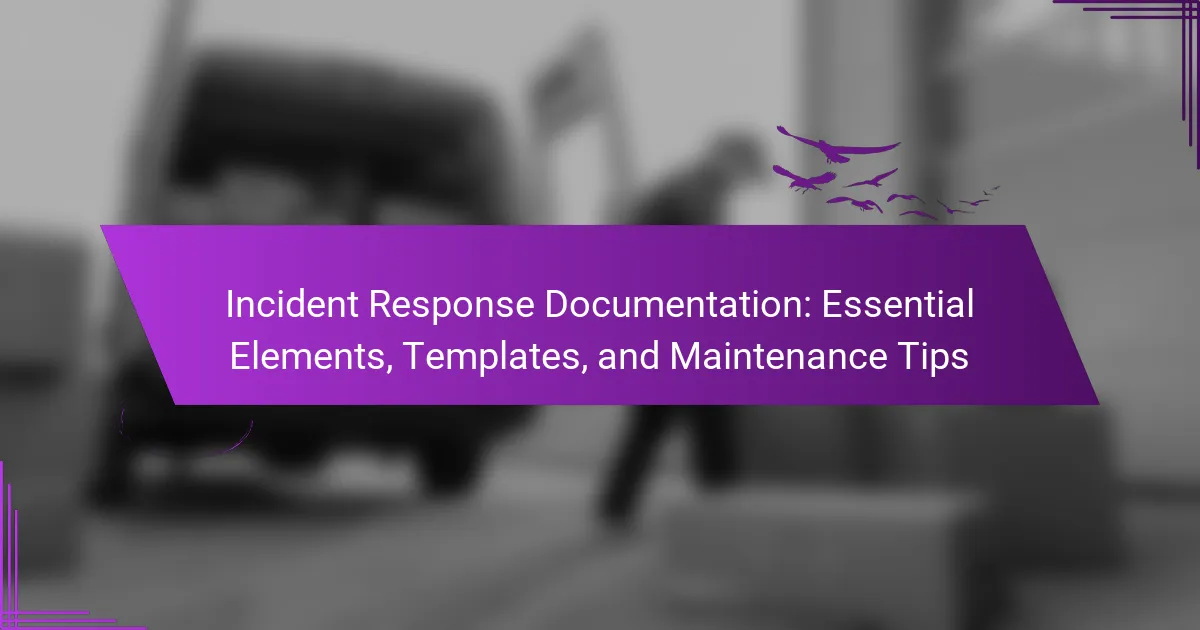
What is Incident Response Documentation?
Incident Response Documentation is a formal record detailing the processes and actions taken during a cybersecurity incident. It serves as a guide for managing incidents effectively and provides a framework for response. This documentation includes incident identification, containment strategies, eradication steps, and recovery procedures. Additionally, it outlines lessons learned and recommendations for future improvements. Proper documentation aids in compliance with legal and regulatory requirements. It also assists organizations in refining their incident response plans over time. Effective documentation can improve response times and enhance overall security posture.
Why is Incident Response Documentation important?
Incident Response Documentation is important because it provides a structured approach to managing security incidents. It ensures that all actions taken during an incident are recorded accurately. This documentation allows for better analysis and understanding of the incident’s impact. It also helps in identifying areas for improvement in security protocols. Furthermore, having detailed records supports compliance with regulatory requirements. According to a study by the Ponemon Institute, organizations with documented incident response plans can reduce the cost of breaches by an average of 20%. This highlights the financial benefits of thorough documentation. Overall, it enhances an organization’s ability to respond effectively to future incidents.
What are the consequences of inadequate documentation?
Inadequate documentation leads to significant consequences in incident response. It results in a lack of clarity about procedures and responsibilities. This can cause delays in responding to incidents. Delays can exacerbate the impact of security breaches. Poor documentation can also hinder communication among team members. It may lead to inconsistent responses to similar incidents in the future. Additionally, inadequate records can complicate compliance with regulations. Organizations may face legal repercussions due to insufficient documentation. Ultimately, these consequences can damage an organization’s reputation and trustworthiness.
How does documentation improve incident response effectiveness?
Documentation improves incident response effectiveness by providing clear guidelines and procedures. It ensures that all team members understand their roles during an incident. Well-documented processes facilitate quicker decision-making and action. This reduces response times and minimizes potential damage. Documentation also aids in training new team members. It serves as a reference for best practices and lessons learned. According to a study by the Ponemon Institute, organizations with documented incident response plans have a 30% faster response time. This highlights the critical role of documentation in enhancing overall incident management.
What are the key components of Incident Response Documentation?
The key components of Incident Response Documentation include an incident response plan, incident classification, roles and responsibilities, communication protocols, and post-incident analysis. An incident response plan outlines the procedures to follow during an incident. Incident classification helps in prioritizing incidents based on severity. Roles and responsibilities define who is accountable for specific tasks during an incident. Communication protocols ensure clear and effective information sharing among stakeholders. Post-incident analysis evaluates the response effectiveness and identifies improvements for future incidents. These components are essential for a structured and efficient incident response process.
What essential elements should be included in the documentation?
Essential elements in incident response documentation include an incident description, timeline of events, and roles and responsibilities. The incident description provides a clear overview of what occurred. The timeline of events outlines the sequence of actions taken during the incident. Roles and responsibilities define who was involved in the response process. Additionally, the documentation should include evidence collected, communication logs, and lessons learned. Evidence collected supports the analysis of the incident. Communication logs track interactions among team members and stakeholders. Lessons learned offer insights for improving future responses. These elements ensure a comprehensive understanding of the incident and facilitate effective future planning.
How does each component contribute to the overall process?
Each component of incident response documentation plays a critical role in the overall process. The incident report provides a detailed account of the event, aiding in accurate analysis. The timeline of events establishes a chronological sequence, helping to understand the progression of the incident. Roles and responsibilities clarify who is accountable for specific tasks during the response. Communication plans ensure that all stakeholders receive timely updates and information. Templates standardize documentation, promoting consistency and efficiency in reporting. Review and maintenance procedures help keep the documentation current and relevant. Each of these components collectively enhances the effectiveness of the incident response process.
What types of Incident Response Documentation exist?
Types of Incident Response Documentation include Incident Response Plans, Incident Reports, and Post-Incident Reviews. Incident Response Plans outline procedures for handling incidents. They provide guidance on roles, responsibilities, and communication strategies. Incident Reports detail the specifics of an incident, including detection, response actions, and resolution steps. They serve as a record for analysis and future reference. Post-Incident Reviews analyze the response effectiveness and identify areas for improvement. These reviews often lead to updates in the Incident Response Plan. Each type of documentation plays a critical role in enhancing an organization’s incident response capabilities.
What formats can Incident Response Documentation take?
Incident Response Documentation can take several formats. Common formats include written reports, spreadsheets, and presentations. Written reports provide detailed narratives of the incident and response actions. Spreadsheets are useful for tracking timelines and resources used during the incident. Presentations summarize key findings and recommendations for stakeholders. Each format serves a unique purpose in conveying information effectively. These formats are widely adopted in cybersecurity practices for their clarity and organization.
How do different types serve various organizational needs?
Different types of incident response documentation serve various organizational needs by providing tailored information for specific scenarios. For example, policies outline the overall framework and expectations for incident handling. Procedures detail step-by-step actions to take during an incident, ensuring consistency and efficiency. Checklists offer quick reference points for responders, reducing the likelihood of oversight. Templates standardize reporting formats, facilitating clear communication among stakeholders. Each type addresses unique aspects of incident management, enhancing preparedness and response effectiveness. According to the National Institute of Standards and Technology (NIST), structured documentation is crucial for improving incident response capabilities and organizational resilience.

How can templates enhance Incident Response Documentation?
Templates enhance Incident Response Documentation by providing a standardized structure for recording incidents. A consistent format ensures that all necessary information is captured efficiently. This reduces the risk of missing critical details during a response. Templates also facilitate quicker training for new team members. With predefined fields, users can focus on content rather than formatting. Additionally, templates can improve collaboration among team members by ensuring everyone follows the same guidelines. Research shows that structured documentation can lead to faster incident resolution times. Therefore, using templates can significantly streamline the documentation process in incident response.
What are the advantages of using templates for documentation?
Templates for documentation streamline the writing process and enhance consistency. They provide a structured format that ensures all necessary information is included. This reduces the time spent on formatting and allows focus on content quality. Templates also improve collaboration among team members. Everyone can follow the same guidelines, which minimizes confusion. Furthermore, templates facilitate quicker updates to documentation. When changes are needed, they can be made uniformly across all instances. Studies show that organizations using templates experience a 30% increase in efficiency in documentation tasks. This efficiency leads to faster incident response times, which is crucial in incident management.
How do templates streamline the documentation process?
Templates streamline the documentation process by providing a structured format for information. They ensure consistency across documents, which enhances clarity and comprehension. Templates save time by reducing the need to create documents from scratch. This allows users to focus on content rather than formatting. Additionally, templates can include predefined fields for essential information. This minimizes the risk of omitting critical details. Studies show that organizations using templates experience improved efficiency in documentation tasks. By standardizing the process, templates also facilitate easier collaboration among team members.
What should be included in an effective incident response template?
An effective incident response template should include clearly defined roles and responsibilities. This ensures accountability during an incident. The template must outline the incident identification process. It should detail how to assess the severity and impact of the incident. A communication plan is essential for informing stakeholders. The template should include step-by-step response procedures. It must also have a section for documenting actions taken. A post-incident review process should be included for continuous improvement. These components help organizations respond effectively to incidents.
How can organizations customize templates for their needs?
Organizations can customize templates by identifying their specific requirements. They should assess their incident response processes and key stakeholders. Tailoring templates to include necessary fields enhances relevance. Organizations can incorporate industry-specific terminology for clarity. Adjusting the layout and design promotes usability. Testing the templates with real scenarios ensures effectiveness. Regular updates based on feedback improve functionality. This approach aligns documentation with organizational goals and compliance standards.
What factors should be considered when customizing templates?
When customizing templates, consider the audience’s needs. Understanding who will use the template is crucial. Tailor the language and complexity accordingly. Next, assess the specific incident response requirements. Identify what information is essential for effective documentation. Incorporate relevant sections that align with your organization’s policies.
Additionally, ensure the template is user-friendly. A clear layout enhances usability. Use consistent formatting for better readability. Finally, review and update the template regularly. This ensures it remains relevant and effective. Regular updates reflect changes in best practices and compliance requirements.
How can feedback improve template effectiveness?
Feedback can enhance template effectiveness by identifying areas for improvement. It allows users to share their experiences with the template. This input can highlight usability issues that may not be apparent to the creator. Incorporating user suggestions can make templates more intuitive and user-friendly. Additionally, feedback can reveal gaps in information that need to be addressed. Continuous updates based on feedback ensure that templates remain relevant and effective. Research shows that iterative improvements based on user feedback lead to higher satisfaction rates. For example, a study by Nielsen Norman Group found that user-centered design significantly improves usability.

What are best practices for maintaining Incident Response Documentation?
Best practices for maintaining Incident Response Documentation include regular updates, clear formatting, and accessibility. Regular updates ensure the documentation reflects the latest procedures and lessons learned. Clear formatting enhances readability and helps users quickly locate information. Accessibility allows all relevant personnel to access the documentation easily. Additionally, conducting periodic reviews of the documentation identifies any gaps or outdated information. Training team members on the documentation process ensures consistency in usage. Incorporating feedback from incident responses improves the documentation’s effectiveness. Lastly, version control tracks changes and maintains historical accuracy. These practices enhance the reliability and usability of Incident Response Documentation.
How often should Incident Response Documentation be reviewed?
Incident Response Documentation should be reviewed at least annually. Regular reviews ensure that the documentation remains relevant and up-to-date. Changes in technology, regulations, and organizational structure can impact incident response procedures. The National Institute of Standards and Technology (NIST) recommends regular updates to maintain effectiveness. Additionally, after any significant incident, a review should occur to incorporate lessons learned. This practice helps improve future incident response efforts.
What processes ensure documentation remains up-to-date?
Regular reviews and updates of documentation ensure it remains up-to-date. Scheduled audits help identify outdated information. Incorporating feedback from incident responses enhances accuracy. Version control tracks changes and maintains a history of updates. Training sessions for team members keep everyone informed of the latest procedures. Automated tools can alert teams to necessary updates based on new incidents. Collaboration among stakeholders ensures comprehensive coverage of all relevant changes. These processes collectively maintain the relevance and effectiveness of incident response documentation.
How can organizations track changes and updates effectively?
Organizations can track changes and updates effectively by implementing a change management system. This system should include version control to monitor alterations in documents and processes. Regular audits can ensure compliance with established protocols. Additionally, using collaborative tools allows team members to log and review changes in real-time. Training staff on the importance of documentation promotes accountability. Automated notifications can alert relevant parties to updates, enhancing communication. Research shows that organizations with structured change tracking reduce errors and improve response times by 30%.
What common challenges do organizations face in maintaining documentation?
Organizations face several common challenges in maintaining documentation. One challenge is keeping documentation up to date. Rapid changes in processes and technologies can render existing documents obsolete. Another challenge is ensuring consistency across documents. Inconsistent formats and terminology can lead to confusion. Additionally, organizations often struggle with accessibility. Employees may have difficulty locating the necessary documents when needed. Moreover, there is the issue of compliance. Regulatory requirements may necessitate specific documentation that can be complex to manage. Finally, training staff on documentation practices can be a challenge. Without proper training, employees may not follow documentation protocols effectively.
How can organizations overcome these challenges?
Organizations can overcome incident response documentation challenges by implementing standardized procedures. Establishing clear templates for incident reports enhances consistency. Regular training sessions for staff improve understanding and adherence to documentation standards. Utilizing automated tools can streamline the documentation process, reducing human error. Regular audits of documentation practices ensure compliance and identify areas for improvement. Engaging stakeholders in the development of documentation policies fosters collaboration and ownership. By prioritizing these strategies, organizations can effectively manage and enhance their incident response documentation efforts.
What tools can assist in effective documentation maintenance?
Tools that can assist in effective documentation maintenance include document management systems, version control software, and collaboration platforms. Document management systems like SharePoint or Google Drive help organize and store documents securely. Version control software such as Git allows tracking changes and managing different document versions. Collaboration platforms like Confluence facilitate team collaboration and real-time updates on documentation. These tools streamline the documentation process and ensure accuracy and accessibility.
What are practical tips for effective Incident Response Documentation?
Effective incident response documentation requires clarity and organization. Start by defining the incident clearly. Include the date, time, and nature of the incident. Document all actions taken during the response process. This should include who was involved and what steps were executed. Use a standardized template to maintain consistency. Ensure that documentation is updated in real-time to capture all relevant details. Review and revise documentation regularly for accuracy. Training team members on documentation practices enhances overall effectiveness. Following these tips can improve incident response efficiency and accountability.
Incident Response Documentation is a formal record that details the processes and actions taken during cybersecurity incidents. This article covers its importance, key components, and the consequences of inadequate documentation. It discusses various types of documentation, including Incident Response Plans and Post-Incident Reviews, as well as the benefits of using templates to enhance documentation efficiency. Additionally, best practices for maintaining and updating documentation are outlined, along with tools and strategies to overcome common challenges in documentation management.
